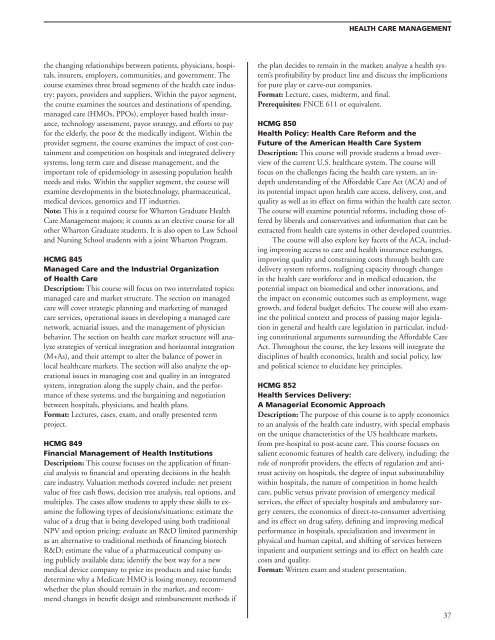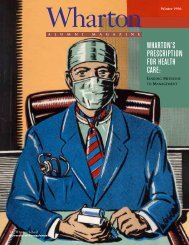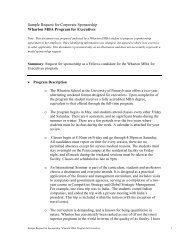Explore Options; Plan Your MBA Academic Program
Explore Options; Plan Your MBA Academic Program
Explore Options; Plan Your MBA Academic Program
Create successful ePaper yourself
Turn your PDF publications into a flip-book with our unique Google optimized e-Paper software.
the changing relationships between patients, physicians, hospitals,<br />
insurers, employers, communities, and government . The<br />
course examines three broad segments of the health care industry:<br />
payors, providers and suppliers . Within the payor segment,<br />
the course examines the sources and destinations of spending,<br />
managed care (HMOs, PPOs), employer based health insurance,<br />
technology assessment, payor strategy, and efforts to pay<br />
for the elderly, the poor & the medically indigent . Within the<br />
provider segment, the course examines the impact of cost containment<br />
and competition on hospitals and integrated delivery<br />
systems, long term care and disease management, and the<br />
important role of epidemiology in assessing population health<br />
needs and risks . Within the supplier segment, the course will<br />
examine developments in the biotechnology, pharmaceutical,<br />
medical devices, genomics and IT industries .<br />
Note: This is a required course for Wharton Graduate Health<br />
Care Management majors; it counts as an elective course for all<br />
other Wharton Graduate students . It is also open to Law School<br />
and Nursing School students with a joint Wharton <strong>Program</strong> .<br />
HCMG 845<br />
Managed Care and the Industrial Organization<br />
of Health Care<br />
Description: This course will focus on two interrelated topics:<br />
managed care and market structure . The section on managed<br />
care will cover strategic planning and marketing of managed<br />
care services, operational issues in developing a managed care<br />
network, actuarial issues, and the management of physician<br />
behavior . The section on health care market structure will analyze<br />
strategies of vertical integration and horizontal integration<br />
(M+As), and their attempt to alter the balance of power in<br />
local healthcare markets . The section will also analyze the operational<br />
issues in managing cost and quality in an integrated<br />
system, integration along the supply chain, and the performance<br />
of these systems, and the bargaining and negotiation<br />
between hospitals, physicians, and health plans .<br />
Format: Lectures, cases, exam, and orally presented term<br />
project .<br />
HCMG 849<br />
Financial Management of Health Institutions<br />
Description: This course focuses on the application of financial<br />
analysis to financial and operating decisions in the health<br />
care industry . Valuation methods covered include: net present<br />
value of free cash flows, decision tree analysis, real options, and<br />
multiples . The cases allow students to apply these skills to examine<br />
the following types of decisions/situations: estimate the<br />
value of a drug that is being developed using both traditional<br />
NPV and option pricing: evaluate an R&D limited partnership<br />
as an alternative to traditional methods of financing biotech<br />
R&D; estimate the value of a pharmaceutical company using<br />
publicly available data; identify the best way for a new<br />
medical device company to price its products and raise funds;<br />
determine why a Medicare HMO is losing money, recommend<br />
whether the plan should remain in the market, and recommend<br />
changes in benefit design and reimbursement methods if<br />
HEALTH CARE MANAGEMENT<br />
the plan decides to remain in the market; analyze a health system’s<br />
profitability by product line and discuss the implications<br />
for pure play or carve-out companies .<br />
Format: Lecture, cases, midterm, and final .<br />
Prerequisites: FNCE 611 or equivalent .<br />
HCMG 850<br />
Health Policy: Health Care Reform and the<br />
Future of the American Health Care System<br />
Description: This course will provide students a broad overview<br />
of the current U .S . healthcare system . The course will<br />
focus on the challenges facing the health care system, an indepth<br />
understanding of the Affordable Care Act (ACA) and of<br />
its potential impact upon health care access, delivery, cost, and<br />
quality as well as its effect on firms within the health care sector .<br />
The course will examine potential reforms, including those offered<br />
by liberals and conservatives and information that can be<br />
extracted from health care systems in other developed countries .<br />
The course will also explore key facets of the ACA, including<br />
improving access to care and health insurance exchanges,<br />
improving quality and constraining costs through health care<br />
delivery system reforms, realigning capacity through changes<br />
in the health care workforce and in medical education, the<br />
potential impact on biomedical and other innovations, and<br />
the impact on economic outcomes such as employment, wage<br />
growth, and federal budget deficits . The course will also examine<br />
the political context and process of passing major legislation<br />
in general and health care legislation in particular, including<br />
constitutional arguments surrounding the Affordable Care<br />
Act . Throughout the course, the key lessons will integrate the<br />
disciplines of health economics, health and social policy, law<br />
and political science to elucidate key principles .<br />
HCMG 852<br />
Health Services Delivery:<br />
A Managerial Economic Approach<br />
Description: The purpose of this course is to apply economics<br />
to an analysis of the health care industry, with special emphasis<br />
on the unique characteristics of the US healthcare markets,<br />
from pre-hospital to post-acute care . This course focuses on<br />
salient economic features of health care delivery, including: the<br />
role of nonprofit providers, the effects of regulation and antitrust<br />
activity on hospitals, the degree of input substitutability<br />
within hospitals, the nature of competition in home health<br />
care, public versus private provision of emergency medical<br />
services, the effect of specialty hospitals and ambulatory surgery<br />
centers, the economics of direct-to-consumer advertising<br />
and its effect on drug safety, defining and improving medical<br />
performance in hospitals, specialization and investment in<br />
physical and human capital, and shifting of services between<br />
inpatient and outpatient settings and its effect on health care<br />
costs and quality .<br />
Format: Written exam and student presentation .<br />
37

















